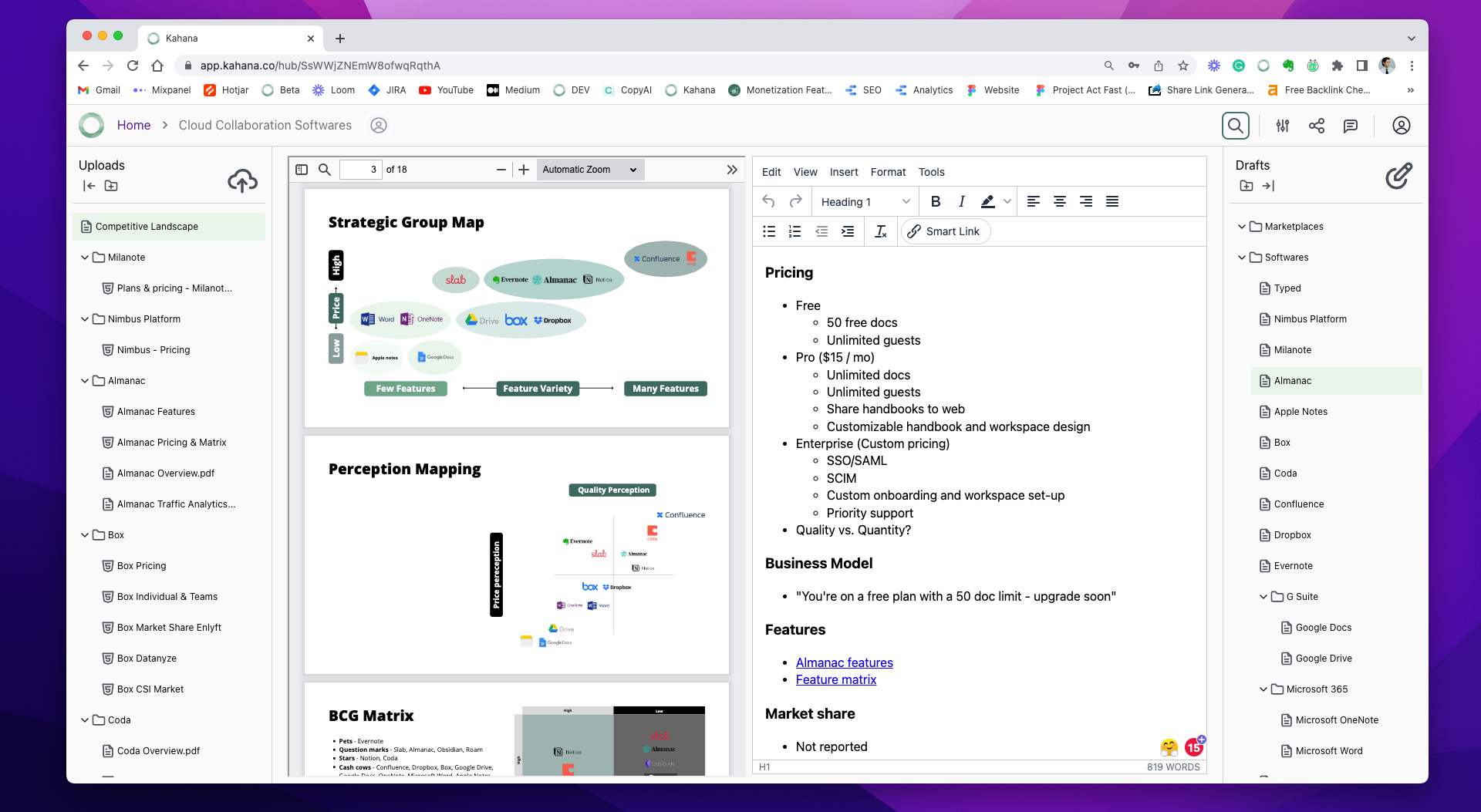Market Research Methods: Examples, Tools, & Template [PDFs]

Topics covered ✅
- Market research methods pdf
- Market research methods examples
- Market research examples
- Types of market research
- Primary market research methods
- Market research methods advantages and disadvantages
- Market research template
You need to have a secure understanding of market research methods if you are currently planning to build a brand or business.
In this article, you'll learn about types of market research, research methods, and what you need to know about customers.
1. Businesses
From start-ups working out of their garage to companies like Amazon, with over 300 million active users, businesses of every size need to invest time and resources into market research in order to be successful.
By being able to recognize consumers’ values and goals, companies can better advertise and tailor their products to customers.
Some companies devote whole teams to generating market research data.
Companies choose to do this because those who utilize effective market research methods have a competitive advantage over others in their industry.
Along with granting a competitive advantage, market research can also provide answers to problems unique to individual businesses.
For example, if a business has found a decrease in sales within the past quarter, market research will allow them to discover the root of the problem and correct it.

Claim My Free Market Research Template
This hub serves as a free template to help you get started and includes free tools, examples, and PDFs for market research.
2. Market
In business, the market is defined as the sum of individuals and groups that make up potential buyers for a good or service. There are five main types of markets that a business may be involved in.
- The first type is business-to-consumer (B2C). In this type of market, goods and services are marketed to consumers. This makes it the largest market since there are millions of consumers worldwide.
- The business-to-business market (B2B) focuses on goods and services that are sold to other businesses. These markets often overlap with B2C markets.
- The service market can be B2B or B2C and deals with sales services.
- The industrial market sells products and services (such as raw materials or equipment) that are used in the production of other goods.
- The professional service market requires some form of certification to be a part of it (such as medical services and financial advisers).
Businesses use market research to identify their particular target market. Once this is established, additional research is conducted on customers within their market.
3. Customers
Each market has a different set of customers.
To better understand potential customers, market researchers conduct segmentation research and categorize customers in four different ways: geographically, demographically, psychographically, and behaviorally.
- Geographic segmentation pertains to customer location in space.
- Demographic segmentation pertains to the characteristics of a customer.
- Psychographic segmentation pertains to psychological attributes.
- Behavioral segmentation pertains to how people act.
One useful tip in market research is to create user personas.
By collecting demographic and psychographic data on customers, businesses find patterns to create representations of types of users.
Personas can be as broad or as specific as you like, but there are three general questions that can lead to a strong persona.
- Who is this persona about?
- What does this persona want?
- What is preventing this persona from getting what they want?
For example, let’s say a smart board company is analyzing its customers.
They may find that 35% of their sales come from school principals.
By asking these and other branding research questions, the whiteboard company comes up with this persona.
Who is this persona about?
School principals.
What does this persona want?
For their teachers to be able to (effectively) present and interact with information online while lecturing in front of the class.
What is preventing this persona from getting what they want?
Their schools are currently equipped with whiteboards that have not been integrated with technology.
Personas are useful because they allow companies to cater to a large group of people in a particular target market.
By leveraging audience research tools, companies can gather data to tweak their products or create unique advertisements to sell to a specific audience because personas provide them with an increased understanding of how a certain group will react.
4. Types of Market Research
There are many types of market research that a company can do.
With that being said, most types of market research fall into these four categories:
- Primary Market Research
- Secondary Market Research
- Qualitative Market Research
- Quantitative Market Research
Primary and secondary market research both relate to where researchers gather information from.
Qualitative and quantitative research, on the other hand, relate to the type of data that is collected during research.
Qualitative Market Research
Qualitative market research is defined as the collection of data from both the primary and secondary markets that cannot be easily measured or expressed in a numerical form.
This type of data is collected through avenues such as interviews and case studies.
Qualitative market research helps in inferring and estimation, but without a lack of numerical data, it can be difficult to point towards conclusions from this type of data as facts.
Quantitative Market Research
Quantitative market research is defined as the collection of data from both the primary and secondary markets that are easily measured or expressed in a numerical way.
Polls and different types of surveys for research are efficient strategies to collect this type of data.
By using statistical analysis, researchers can use such data to (accurately) express patterns and predict trends.
While this data is great for producing reliable evidence, it can be restrictive.
Quantitative market research makes it difficult to provide context or let participants tailor their responses.
Researchers should strive to collect quantitative and qualitative data.
A combination of these types of data can provide an even greater picture of the market as a whole.
5. Primary Market
Primary market research is information that researchers collect themselves from primary sources.
Primary sources are any sort of raw, first-hand data that is collected straight from the subject in question.
By going directly to current or potential customers, companies can gather the information that their competitors do not have.
This can be through interviews, online surveys, product testing market research, or other methods of study. Within this type of research, there are two types of results.
- Exploratory results - general, open-ended research conducted to determine the nature of a problem that is not yet fully understood.
- Conclusive results - more precise, often quantitative research that is done to solve the problem that was scoped out through exploratory research.
6. Secondary Market
Secondary market research is information that researchers collect from secondary sources.
Secondary sources can come from public sources, commercial sources, and educational institutions.
Public sources include public libraries and government websites.
Commercial sources include newspapers and television recordings.
Professors and project teams working at educational institutions frequently publish their findings, which can be very beneficial to researchers as well.
By conducting this type of research, companies either hope to discover previously overlooked trends, or work to apply a new perspective toward historical data.
In the past, this type of research was carried out by going to libraries and reading through old files.
Now, however, researchers have coined the term “desktop research” when referring to secondary market research.
There are thousands of reliable websites to source data from, making this type of research very easy to be carried out without leaving one's computer.
7. Market Research Method
There are six basic steps to conducting market research:
Step 1. Define your problem
This step sets up researchers with a goal for their project.
By defining what you want to research, it's easier to come up with additional questions to ask.
Are you conducting branding market research? Customers? Competitors? Testing products?
These are all important questions to ask yourself when thinking about your problem.
Step 2. Define your sample
Who is the target market being sampled?
By defining your sample, it's easier to gear questions towards subjects, as well as draw conclusions about the people participating in the research.
Step 3. Collect your data
This step in the research process will differ based on if you want to collect qualitative or quantitative data.
The most common types of data collection through observation are surveys, focus groups, interviews, and direct observation (explained in detail below).
Step 4. Analyze data and draw conclusions
This step determines what you take away from the data that was collected.
Step 5. Create a research report
A research report is how you display your findings to others who are going to use them. Research is useless if people cannot understand or interpret the data.
Step 6. Take future steps
After analyzing the research reports, the next step is to see what future work there is to be done.
Often the market research process will start over again, this time with a new problem and goal based on previous research.
8. Observation
Researchers observe participants in many ways.
Listed below are four ways that primary market research data can be collected.
- Surveys - Surveys are questionnaires sent out to a sample of potential customers. These questionnaires ask questions about consumer behavior in relation to your products or services. Online surveys are the easiest and most effective type of survey, compared to mail-in and over-the-phone methods. Surveys are an effective way to collect information quickly and inexpensively because they require very little time or money on your part; however, they can only answer questions that relate directly back to your products or services.
- Interviews - Interviews are one-on-one conversations that a researcher has with a customer or potential customer. Interviews can be beneficial, as they provide insight into a customer’s experience, as well as emotions that surveys may not be able to pick up on.
- Focus Groups - Focus groups are similar to interviews, except they're conducted in a group setting. They can also be beneficial, in the sense that more people are questioned face to face. Pitfalls of this type of method, however, include group conformity (where group members converge towards the same answers) and moderator bias.
- Direct Observation - Observation is when researchers record what they see the subject do. This can be done in the subject's natural environment or in a controlled setting. This is the most powerful type of research because researchers are able to see participants interact with their product organically (with no outside influences).
9. Marketing
The data collected from market research is what leads companies to develop unique marketing strategies.
User personas allow companies to market directly to a particular group of people.
Market research also provides companies with information on which market their product will perform the best in, which in turn influences marketing strategies.
10. Product
At the end of the day, the marketing methods used will ultimately depend on what your product is.
Local companies will have a very different research and marketing strategy than companies that operate globally.
Researchers must identify and carry out different research methods based on their product.
This can only be done successfully if they have a strong understanding of market research methodology.

Talk with a Kahana representative
Fill out your information and a Kahana team representative will reach out to you. Have a simple question? Search our library of articles
